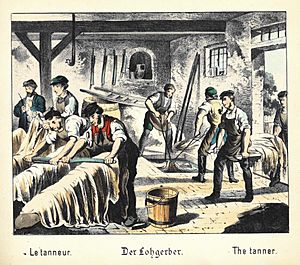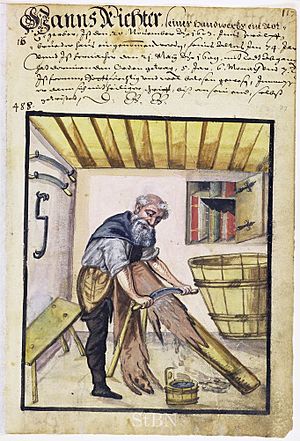Tanning facts for kids
Tanning is a special process that changes animal skin into leather. Think of it like magic for animal hides! This process makes the skin much stronger and more flexible. It also helps protect the skin from tiny germs (bacteria) that could damage it. Tanning often changes the skin's color too.
Contents
What is Tanning?
Tanning is all about making animal skin last a long time. Without tanning, animal skins would quickly rot away. Leather, on the other hand, can be used to make many useful things like shoes, belts, bags, and even furniture.
Getting Skins Ready
Before tanning can begin, animal skins need a lot of preparation. First, the skin is carefully removed from the animal. Then, any extra bits of flesh or fat on the inside of the skin are scraped off. All the hair on the outside of the skin is also removed.
Next, the skins are cleaned thoroughly. They are soaked in water, sometimes for a day or two, to wash away any salt that was used to preserve them. This step makes sure the skins are soft and ready for the next part of the process.
How Tanning Works
The main part of tanning involves soaking the prepared skins in a special liquid. Today, a chemical called Chromium sulfate is often used. This chemical helps to change the skin's structure, making it strong and durable.
Long ago, people used a natural substance called tannin. This tannin came from plants, especially from the bark of trees like oak or fir. They would soak the skins in baths made from these tree barks for a very long time, sometimes even months! This old method is called "vegetable tanning."
The Tanner's Job
A tanner is the person who does this important work of turning skins into leather. It's a skilled job that has been around for thousands of years.
A tannery is the place where tanners work. Because the tanning process can be quite smelly, tanneries were often built on the edge of towns, away from homes.
Tanning and the Environment
In the past, the liquids used in tanneries sometimes caused pollution if they were dumped into rivers. However, today, many tanneries use special methods to clean their wastewater before it goes back into the environment. This helps protect our rivers and the creatures that live in them.



